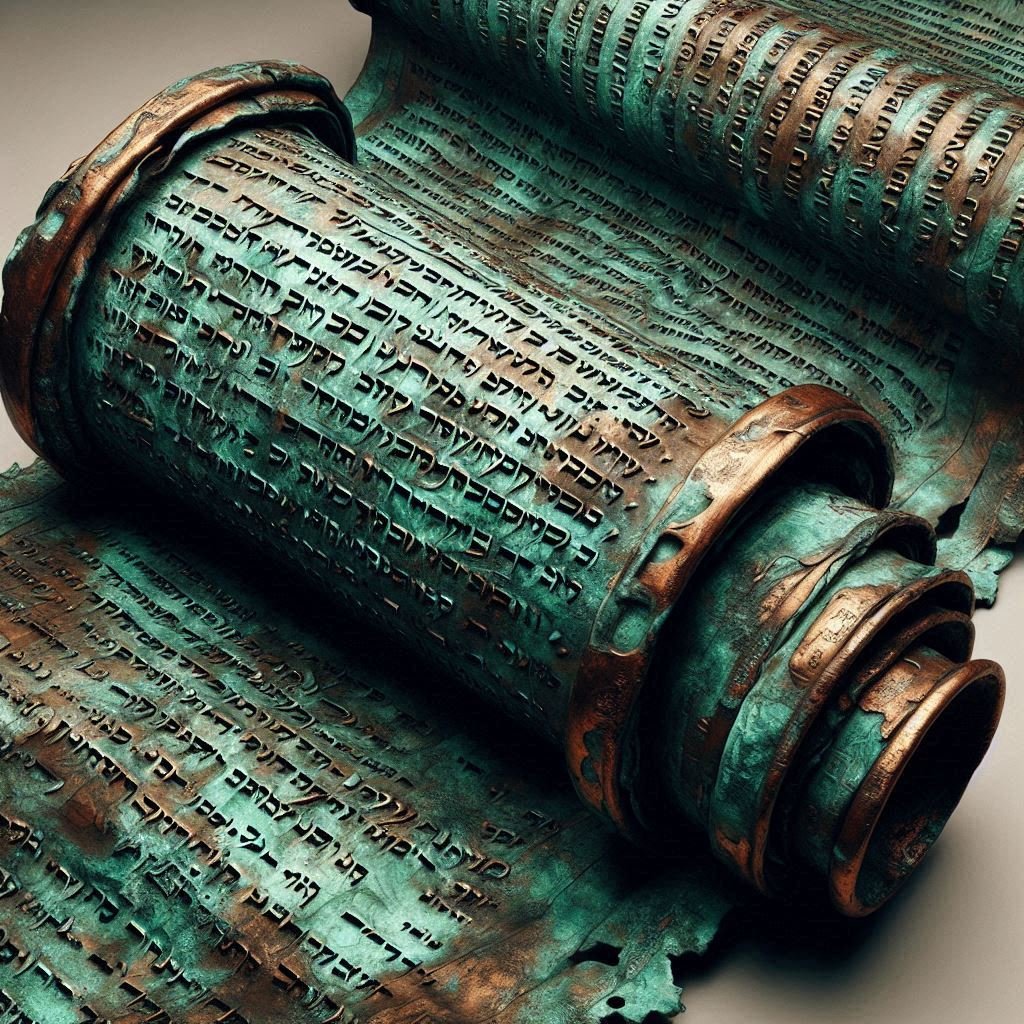Imagine stumbling across an ancient map, not on paper, not carved into stone, but hammered into pure copper. And this map doesn’t just lead to a single treasure chest filled with gold coins. No. This one claims to mark the locations of sixty-four different treasure hoards—vast sums of silver and gold, buried in secret places across a desert landscape. It sounds like something straight out of an Indiana Jones movie, but this is no Hollywood script. This is real.
The Copper Scroll, one of the most mysterious of the Dead Sea Scrolls, was discovered in 1952 in the caves near Qumran, and it has baffled scholars, treasure hunters, and conspiracy theorists ever since. What does it mean? Is it describing real treasure or just symbolic riches? And if it is real, where did it come from—and why has no one ever found it?
Tonight, we’re diving into one of the strangest archaeological mysteries of all time, a story of buried wealth, lost civilizations, and an ancient map that might be the most elaborate treasure hunt in human history.
The Discovery
The year was 1952. In the dusty hills near the Dead Sea, archaeologists were searching the caves around Qumran, a site already famous for the discovery of the Dead Sea Scrolls just a few years earlier. Those scrolls had been written on parchment and papyrus, containing religious texts, laws, and wisdom literature from a Jewish sect that lived around the time of Jesus.
But when researchers entered what would become known as Cave 3, they found something that shocked them. Unlike the fragile parchment scrolls, this one was made of copper sheets, hammered thin and riveted together. The scroll wasn’t elegant or religious in tone—it was crude, clunky, and badly corroded. In fact, it was so oxidized that it couldn’t even be unrolled safely.
To read it, scientists had to cut it into strips. And once they did, the words carved into the copper revealed something no one was expecting. It wasn’t prophecy. It wasn’t scripture. It was a list. A list of treasure.
The Contents of the Scroll
The Copper Scroll described, in cold, matter-of-fact detail, the locations of sixty-four different hiding places. Each entry read like instructions:
“In the ruin that is in the valley of Achor, under the steps leading to the east, forty talents of silver are buried.”
Another might say: “In the cistern at the base of the great rock, under the stairs, sixty-five gold ingots.”
And on and on it went. Item after item, location after location. If the descriptions were true, the total treasure would amount to tons of gold and silver. Some estimates place its value in the billions of dollars today.
But unlike a fairy tale, these weren’t vague riddles. They were specific. Distances were given in cubits. Landmarks were described. It read less like a myth and more like a field guide for someone who actually needed to retrieve the loot.
This begged the question: who wrote this, and why?
Theories of Origin
Scholars have debated the origin of the Copper Scroll for decades, and the theories are as wild as the treasure it describes.
Some argue it was created by the Jewish sect known as the Essenes, the same community that lived at Qumran and is thought to have authored many of the Dead Sea Scrolls. According to this idea, the Essenes may have been safeguarding the wealth of the Temple in Jerusalem, hiding it from the advancing Romans around the time of the Jewish Revolt in 70 CE.
Others think it wasn’t the Essenes at all, but priests from the Second Temple itself. Perhaps they smuggled out the treasures before the Romans destroyed the Temple, intending to return for it later.
And then there are those who believe the Copper Scroll is essentially a hoax or a symbolic text—meant not to direct anyone to actual treasure, but to represent spiritual riches.
But here’s the problem: no one can prove any of these theories, because no one has ever found the treasure.
The Treasure Hunts
The moment the Copper Scroll’s contents were made public, it set off a frenzy. Adventurers, treasure hunters, even governments wanted to be the first to uncover its secrets. Expeditions scoured the Judean Desert, searching caves, cisterns, and ruins. They dug where the scroll seemed to point.
But they came up empty-handed.
Not a single coin, not a single ingot of gold or silver, has ever been recovered from any of the listed locations. It’s as if the map leads to nothing. Or maybe the treasure was found centuries ago and already looted, leaving behind only a list that has lost its meaning.
The failure to find anything only made the mystery bigger. If the Copper Scroll was fake, why carve it into metal, a process so difficult and expensive that it almost guarantees importance? And if it was real, how could such specific instructions lead nowhere?
Clues Hidden in Plain Sight
Some researchers argue that the treasure is real, but the scroll itself is coded. Distances might have been altered, landmarks deliberately mislabeled. Others suggest the terrain has changed dramatically in 2,000 years—streams have dried up, ruins have collapsed, and new cities have been built on top of the old ones. What was once obvious may now be unrecognizable.
There are also whispers of a cover-up. Some claim that fragments of the treasure were found but quietly removed by governments or private collectors to keep the discovery secret. Others argue that the scroll points to the lost treasures of the First Temple, built by King Solomon, and that its discovery would rewrite biblical history—something too explosive for authorities to allow.
The truth? We don’t know.
The Copper Scroll and the Ark of the Covenant
Here’s where the story takes a sharp turn into conspiracy and legend. Some fringe researchers believe the Copper Scroll doesn’t just point to piles of silver and gold—it points to the most sacred relic of all time: the Ark of the Covenant.
The Ark, according to the Bible, was the chest built to hold the Ten Commandments. It was said to be unimaginably powerful, capable of striking down armies, splitting rivers, and communicating with God himself. The Ark disappeared from history after the destruction of the First Temple, and its location has been debated for centuries.
Could the Copper Scroll be the missing link? Could those coded instructions be pointing toward the hiding place of the Ark itself?
It’s a tantalizing idea. One that fuels documentaries, books, and late-night discussions among conspiracy theorists.
Why Copper?
One of the strangest aspects of the scroll is its material. Why carve this onto copper instead of writing it on parchment like every other Dead Sea Scroll?
Some suggest the answer is simple: permanence. If you were going to record the locations of billions of dollars in treasure, you wouldn’t trust fragile paper that could rot or burn. You’d etch it into something meant to last forever.
But there’s another angle. Copper wasn’t just durable—it was expensive. Whoever commissioned the scroll had resources, authority, and a serious reason to make sure this information survived. That fact alone makes many experts lean toward the idea that the treasure was very real.
The Legacy of the Mystery
Today, the Copper Scroll sits in the Jordan Museum in Amman, Jordan. Scholars continue to study it, argue about it, and debate its meaning. Tourists walk past it, marveling at the strange artifact, perhaps not realizing they’re looking at what some consider the oldest treasure map in the world.
But the mystery lingers. If the treasure ever existed, it remains hidden. If it was symbolic, the symbolism is still unclear. And if it was a hoax, it’s the most elaborate and puzzling one in archaeological history.
The Copper Scroll doesn’t give us answers—it only raises more questions. And that’s why, seventy years after its discovery, people are still obsessed with it.
Why This Story Endures
The Copper Scroll isn’t just about treasure. It’s about the possibility of rewriting history. If the hoards exist, they prove that Jewish groups during the Second Temple period held immense wealth, and that some of it may have survived Rome’s destruction. If the Ark of the Covenant is hidden among the treasures, the implications would shake the world.
But even if none of that is true—even if the Copper Scroll is just a curious artifact with no real treasure behind it—it still grips us. Because deep down, humans love a mystery. We love the idea that somewhere out there, just beneath the earth, unimaginable treasure waits for the person clever enough, brave enough, or lucky enough to find it.
And maybe, just maybe, the Copper Scroll is still waiting for someone to crack its code.




